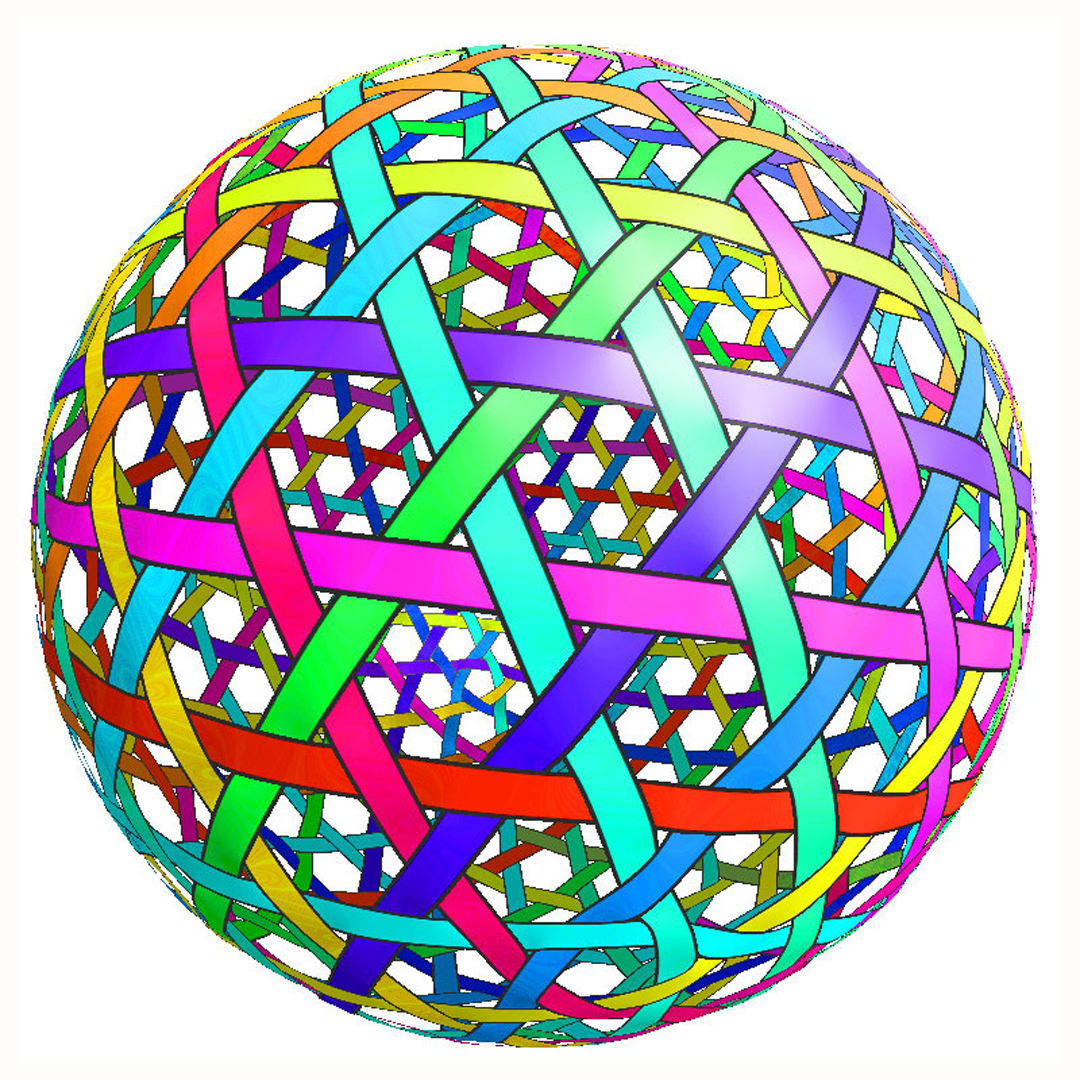“Cyclic plain-weaving on polygonal mesh surfaces with graph rotation systems” by Akleman, Chen, Xing and Gross
Conference:
Type(s):
Title:
- Cyclic plain-weaving on polygonal mesh surfaces with graph rotation systems
Presenter(s)/Author(s):
Abstract:
In this paper, we show how to create plain-weaving over an arbitrary surface. To create a plain-weaving on a surface, we need to create cycles that cross other cycles (or themselves) by alternatingly going over and under. We use the fact that it is possible to create such cycles, starting from any given manifold-mesh surface by simply twisting every edge of the manifold mesh. We have developed a new method that converts plain-weaving cycles to 3D thread structures. Using this method, it is possible to cover a surface without large gaps between threads by controlling the sizes of the gaps. We have developed a system that converts any manifold mesh to a plain-woven object, by interactively controlling the shapes of the threads with a set of parameters. We have demonstrated that by using this system, we can create a wide variety of plain-weaving patterns, some of which may not have been seen before.
References:
1. Akleman, E., and Chen, J. 1999. Guaranteeing the 2-manifold property for meshes with doubly linked face list. International Journal of Shape Modeling 5, 2, 149–177.Google ScholarCross Ref
2. Akleman, E., and Chen, J. 2006. Regular mesh construction algorithms using regular handles. In Proc. of SMI 2006, 171–181. Google ScholarDigital Library
3. Akleman, E., Srinivasan, V., Melek, Z., and Edmundson, P. 2004. Semi-regular pentagonal subdivision. In Proc. of SMI 2004, 110–118. Google ScholarDigital Library
4. Akleman, E., Srinivasan, V., and Mandal, E. 2005. Remeshing schemes for semi-regular tilings. In Proc. of SMI 2005, 44–50. Google ScholarDigital Library
5. Akleman, E., Srinivasan, V., Chen, J., Morris, D., and Tett, S. 2008. Topmod3d: An interactive topological mesh modeler. In Proc. of CGI 2008, 10–18.Google Scholar
6. Akleman, E., Chen, J., Gross, J., and Xing, Q. 2009. Graph rotation systems as a model for cyclic weaving on orientable surfaces. Technical Report TR 2009-4-4, Computer Science Department, Texas A&M University.Google Scholar
7. Baumgart, B. J. 1972. Winged-edge polyhedron representation. Master’s thesis, Technical Report CS-320, Stanford University. Google ScholarDigital Library
8. Catmull, E., and Clark, J. 1978. Recursively generated b-spline surfaces on arbitrary topological meshes. Computer Aided Design, 10, 350–355.Google ScholarCross Ref
9. Doo, D., and Sabin, M. 1978. Behavior of recursive subdivision surfaces near extraordinary points. Computer Aided Design, 10, 356–360.Google ScholarCross Ref
10. Edmonds, J. 1960. A combinatorial representation for polyhedral surfaces. Notices American Mathematics Society, 7, 646.Google Scholar
11. Gross, J. L., and Tucker, T. W. 1987. Topological Graph Theory. Wiley Interscience, New York. Google ScholarDigital Library
12. Grunbaum, B., and Shephard, G. 1987. Tilings and Patterns. W. H. Freeman and Co, NY. Google ScholarDigital Library
13. Guibas, L., and Stolfi, J. 1985. Primitives for the manipulation of general subdivisions and computation of voronoi diagrams. ACM Transaction on Graphics, 4, 74–123. Google ScholarDigital Library
14. Kalberer, F., Nieser, M., and Polthier, K. 2007. Quadcover – surface parameterization using branched coverings. 10–19.Google Scholar
15. Kaplan, M., and Cohen, E. 2003. Computer generated celtic design. In Proc. of 14th Eurographics Workshop on Rendering, 9–16. Google ScholarDigital Library
16. Kaplan, M., Praun, E., and Cohen, E. 2004. Pattern oriented remeshing for celtic decoration. In Proc. of Pacific Graphics 2004, 199–206. Google ScholarDigital Library
17. Kaplan, C. S. 2007. Semiregular patterns on surfaces. In Visual Proc. of ACM SIGGRAPH 2007: sketches, 78. Google ScholarDigital Library
18. Kobbelt, L. 2000. √3-subdivision. In Proc. of SIGGRAPH 2000, 103–112. Google ScholarDigital Library
19. Loop, C. 1987. Smooth Subdivision Surfaces Based on Triangles. Master’s thesis, University of Utah.Google Scholar
20. Mallos, J., 2009. How to weave a basket of arbitrary shape. Accepted to ISAMA 2009; also see http://jamesmallos.blogspot.com/.Google Scholar
21. Mantyla, M. 1988. An Introduction to Solid Modeling. Computer Science Press, Rockville, Ma. Google ScholarDigital Library
22. Mercat, C. 2001. Les entrelacs des enluminure celtes. Dossier Pour La Science 15 (January).Google Scholar
23. Oswald, P., and Schröder, P., 2003. Composite primal/dual √3-subdivision schemes. Computer Aided Geometric Design, CAGD. Google ScholarDigital Library
24. Peters, J., and Reif, U. 1997. The simplest subdivision scheme for smoothing polyhedra. ACM Transactions on Graphics 16, 4, 420–431. Google ScholarDigital Library
25. Scardino, F. L., and Ko, F. K. 1981. Triaxial woven fabrics. Textile Research Journal 51, 2, 80–89.Google ScholarCross Ref
26. Zorin, D., and Schröder, P., 2002. A unified framework for primal/dual quadrilateral subdivision schemes. Computer Aided Geometric Design, CAGD. Google ScholarDigital Library




